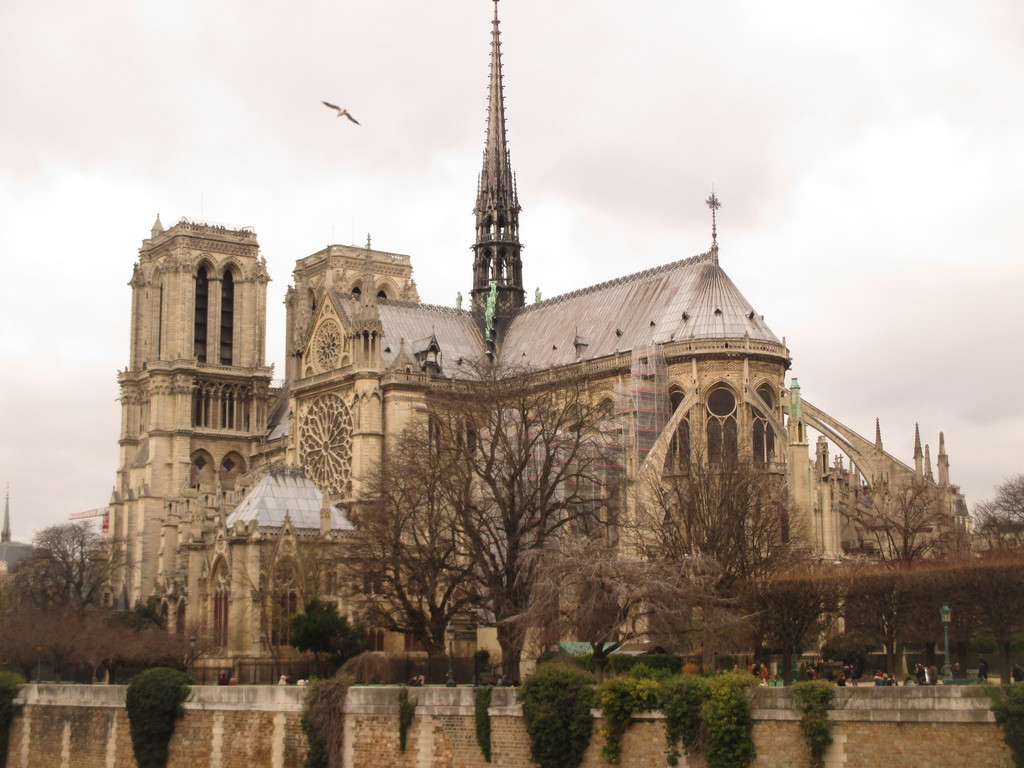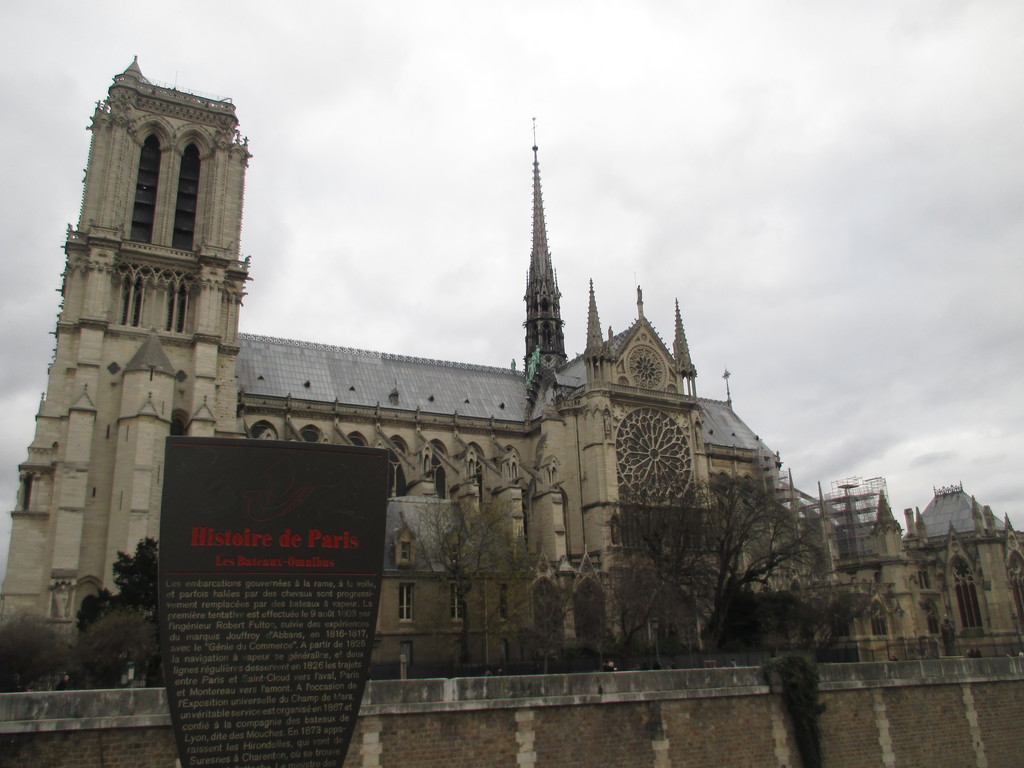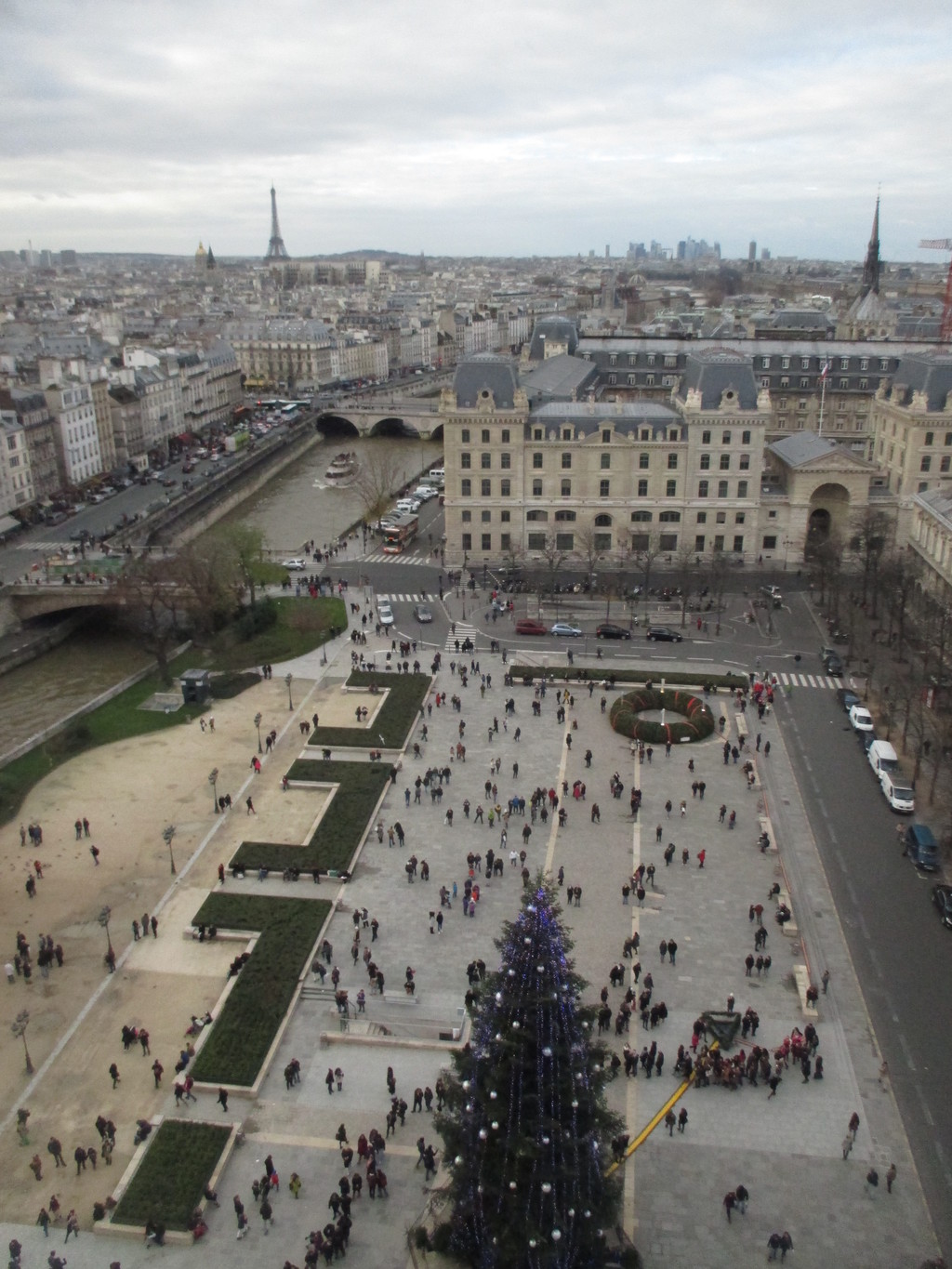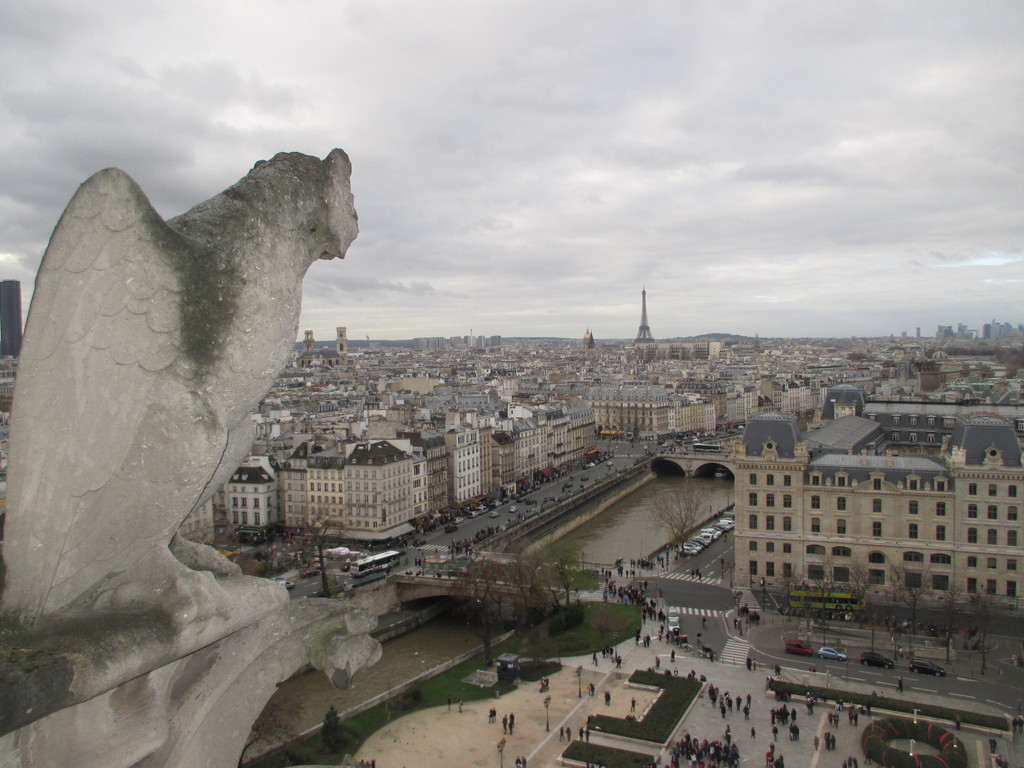Notre Dame Cathedral
- Address: 6 Parvis Notre-Dame - Pl. Jean-Paul II 75004 Paris Francia
- Tags:
 What to see Paris,
Paris,
France
What to see Paris,
Paris,
France
- Telephone: +33 1 42 34 5
- Website: www.notredamedeparis.fr
Notre Dame Cathedral

HISTORY OF THE NOTRE DAME CATHEDRAL:
The Notre Dame Cathedral in Paris is found in the place of the first Christian church of Paris, the Saint Etienne basilica, which was, in its time, constructed over the site of a Roman temple for Jupiter.
The first version of Notre Dame was a "magnificent church" constructed by Childeberto I, king of the Franks at the time, in 528, and it was already the cathedral of the city of Paris in the 10th century. However, in 1160, after having converted into the "parish church of the kings of Europe", Bishop Maurice de Sully considered the building unworthy of his noble rule and had it demolished.
The construction of the current cathedral began in 1163, during the reign of Louis VII, and opinion differs as to whether or not Bishop Maurice de Sully or Pope Alexander III laid the first stone of the cathedral.
The construction of the western exterior, with its distinctive two towers, began around 1200 before having finished the nave. During the construction period, numerous architects worked on the site, as evidenced by the different styles and different heights in the front part and the western towers.
Between 1210 and 1220, the fourth architect supervised the construction of the level with the rose window and the grand rooms underneath the towers. The towers were completed around 1245 and the cathedral was completed around 1345.
During the reigns of Louis XIV and Louis XV at the end of the 17th century, the cathedral underwent some major alterations, during which many tombs and stained glass windows were destroyed.
In 1793, the cathedral was a victim of the French Revolution. Many sculptures and treasures were destroyed or ransacked; the cathedral was dedicated to the Cult of Reason and much later to the Cult of the Supreme Being. Lady Liberty substituted the Virgin Mary in various alters. The cathedral also came to be used as a cellar for the storage of foods.
Napoleon Bonaparte, who was declared Emperor on the 28th of May, 1804, was crowned Emperor in Notre Dame on the 2nd of December, 1804.
A restauration programme began in 1845, under the supervision of the architects Jean-Baptiste-Antoine Lassus and Eugène Viollet-le-Duc. The restauration lasted 23 years, and included the construction of a tower.

In 1871, a civil uprising that drove the establishment of the short-lived Paris Commune nearly set fire to the cathedral, and some records suggest that a collection of chairs within the cathedral were set alight. In 1905, the law of the separation of the church and state was passed; like all the cathedrals, Notre Dame continued being property of the state, but its usage conceded to the Roman Catholic church.
The Te Deum Mass took place in the cathedral to celebrate the liberation of Paris on the 26th of August, 1944. The Requiem Mass of General Charles de Gaulle took place in the cathedral on the 12th of November, 1970.
In 1991, an important restoration programme was effectuated. They expected it to last 10 years, but it continued well into the 21st century. The cleaning and restoration of the ancient sculptures was extremely delicate work. But now the scaffolding is down and the result is spectacular: the architecture in the stones and sculptures shine in their original honey tones instead of industrial black.
THE CRYPT
In the part in front of the Notre Dame is a square. Until the middle of the 60s, this place was a labyrinth of buildings that dated back to the Middle Ages, which is why it is difficult to see the cathedral in all its glory. When the buildings were finally demolished, the archaeologists discovered many remains from the Gallo-Roman, brought to life in the 19th century.
In 1965, an excavation began, supervised by the "Direction of Historical Antiquities on the Isle of France" (M. Fleury, manager) and the "Commission of Old Paris". A museum, the Archaeological Crypt of Notre Dame, was erected by the city of Paris in order to house these remains of the previous civilization. It's the largest structure of its kind in the world (total length: 118 metres, length of the beam: 12 metres).

THE DOORS
The three western doors of the Notre Dame cathedral are magnificent examples of early Gothic art. Sculpted between 1200 and 1240, they depict scenes from the life of the Virgin Mary, the Last Judgement and scenes from the life of Saint Anne (mother of the Virgin Mary). Many of the statues, especially the largest ones, were destroyed in the Revolution and rebuilt in the 19th century.
The Portal of Judgement (Central Portal).
The central western door was sculpted last out of the three in the years 1220 and 1230, and its theme is the Last Judgement, with Christ emphasised less as a judge and more as the savior of the suffering of humanity. Click here for an illustrated guide of the sculpures of the the Last Judgement Portal.
Portal of Saint Anne (Right Portal)
The Portal of Saint Anne was the first of the three western doors to be installed (around 1200) and its tympanum is an earlier Romanesque work of the ancient cathedral by Saint Stephen, dating from around 1150. Anne is the mother of the Virgin Mary, which is mentioned in the stories of the first Christians, but not in the Bible.
The tympanum shows the Virgin with the Son on a throne, accompanied by two angels, a bishop and his assistant, and a king. The upper lintel depicts scenes from the arrival of Christ (Annunciation, Nativity, the Three Wise Men etc. ) and the interior lintel tells the story of Anne and Joaquin and Mary and Joseph.
In the mullion is a statue of Saint Marcel, a bishop of Paris from the 5th century that slayed a dragon that symbolises the scourges with which his diocese was cursed. The statues of Peter, Paul and biblical monarchs (all rebuilt in the 19th century) are found on the door-jamb. The wooden doors have metalwork originating from the 13th century.
Portal of the Virgin (Left Portal)
The Portal of the Virgin, dedicated to the patron saint of the cathedral, is generally the exit door for modern visitors. It was sculpted second out of the three doors between 1210 and 1220. Unlike the other door western doors, this one is crowned with a gable.
The tympanum shows the coronation of the Virgin, with an angel that crowns Mary, whilst Christ blesses her and gives her a sceptre. The upper lintel represents the death of the Virgin - Mary is found on her death bed (which corresponds to the Nativity bed placed in the same position on the right-hand door) surrounded by Jesus and the twelve disciples. Two angels at her head and feet lift her into the sky. The lower lintel has three prophets of the Old Testament (left) and three kings of the Old Testament (right). The scrolls that they hold all represent the prophecies of Christ.
The archivolts are populated with the Celestial Court (angels, patriarchs, kings, prophets). The statues on the door-jamb, destroyed in the Revolution and reconstructed in the 19th century, represent, from left to right: the Emperor Constantine, an angel, Saint Denis with his head, another angel, Saint John the Baptist, Saint Stephen, Saint Genevieve and Pope Sylvester I. In the mullion there is a statue at the foot of the Virgin and the Son, with the pedestal below carved with scenes of the temptation and fall of Adam and Eve.
The door brackets have panels that represent the natural universe, or life on earth. The panels on either side of the door have fading but elegant Zodiacs and works of the months. The positioning of the months echo the annual cycle of the sun: it rises in the sky from January to June (left door-jamb), to then descend from July to December (right door-jamb). Completing the symbolic medieval universe in the lower door-jamb are the seasons (left) and the ages of man (right).
Southern Portal Crossing
The southern portal crossing is dedicated to Saint Stephen. The lower section of the tympanum represents scenes from his life: the ordinance, the prediction and the confrontation with the Jewish council. The upper part depicts his death by stoning, with Saul himself on the left with a mountain of rope at his feet, and a scene possibly related to the finding of his relics on the right.
Northern Portal Crossing
The north transept portal has a statue of the Virgin Mary from the 13th century in the mullion that managed to survive the Revolution. The lower section of the tympanum depicts scenes related with the birth of Christ (the Nativity, the Presentation and the slaughter of the innocent) whilst the two upper levels show the miracles of Saint Theodore.

THE WESTERN FRONT
The western façade of the cathedral is one of its most notable characteristics, with its two 69 metres (228 feet) high towers. The Southern Tower houses the famous bell of the cathedral: "Emmanuel". The bell weighs 13 metric tonnes (28, 000 pounds), it's clapper weighs only 500 kilograms. The bell is from the most ancient Notre Dame, after having been reconstructed in 1631.
The Galerie des Chimères or the Grand Gallery connects the two western towers and it is where the legendary gargoyles of the cathedral (chimères) can be found. The gargoyles are full of Gothic character, but they aren't medieval - they were actually added during the restoration in the 19th century.
The King's Gallery is a line of statues of the 28 king of Judas and Israel, which was redesigned by Violett-le-Duc in order to replace the statues that were destroyed during the French Revolution. The revolutionaries mistakenly believed that the statues were of French kings and not biblical kings, so they beheaded them. Some of the heads were found during an excavation in about 1977 and are now on exhibition in the Museum of the Middle Ages.
In a gorgeous rose window on the western side from about 1220.
THE STAINED GLASS WINDOWS
The stained glass windows in the Notre Dame cathedral are very beautiful and a significant number of them date to the 13th century, when the cathedral was constructed. In the opinion of this author, the collection of stained glass windows in Notre Dame is not as impressive as those of other French cathedrals, such as Chartes and Bourges, and in Paris the best place for enjoying the general effect of the stained glass windows probably isn't Notre Dame but Saint-Chapelle.
However, the stained glass windows of Notre Dame continue being an important and beautiful collection of 13th century Gothic art, with interesting details that are worth examining in more detail. The highlight - and the greatest survival of original glass - is the set of three beautiful windows, which shine like jewels over the western door and it was risen in the north and south crossings.
West Rose (around 1220)
The western rose window of Notre Dame is 10 metres in diameter and of great beauty. Dated to around 1220, it has retained the majority of its original glass and tracery. The main focus of the western rose window is human life, with symbolic themes such as the Zodiacs and works of the months. In the exterior, which is headed by a statue of the Virgin and the Son accompanied by angels. Unfortunately, the interior view of the tinted medieval glass is now more than half blocked by a grand organ.
Southern Rose (around 1260)
The southern rose window was donated by King Louis and installed around 1260. Designed by Jean de Chelles and Pierre de Montreuil, its main themes are the New Testament, the triumph of Christ and the symbolic figure of four.
Repaired more than once over the centuries (in 1725 and 1727 by Guillaume Brice and again in 1861 by Viollet-le-Duc and Alfred Gerente), many of the panels are now out of order. Furthermore, Viollet-le-Duc rotated the entire rose by 15° in order to create horizontal and vertical shafts for masonry stability.
The southern rose window is 12. 9 metres in diameter and has 84 sheets of glass. They radiate outwards from a central medallion of Christ, it consists of four concentric circles of 12 medals, 24 medallions, quadrilobes and 24 trilobes.
The original central medallion was lost; probably representative of Christ in all his Grace. It was replaced in 1726 by the coat of arms of Cardinal de Noailles, the archbishop of Paris who restored the window. Viollet-le-Duc replaced it with a modern Christ of the Apocalypse. The original medallions that surround it are:
- 12 disciples (in the first and second circles)
- 20 angels that hold a candle, two crowns and a censer (fourth circle); the wise virgins; biblical scenes such as the flight to Egypt, the healing of the paralytic, the Judgement of Solomon and the Annunciation (third and fourth circle); saints and martyrs, including Laurence with his grill, Denis holding his head, Pothin (Bishop of Lyon), Marguerite and a dragon, Blandine and two lions, George, Amrbosio and Eustatius; scenes of exceptional quality dating to the 12th century, that represent the life of Saint Matthew (third and fourth circle)
The pieces in the corners represent: the Descent into Hell (left) with Moses and Aaron (above); the temptation of Adam and Eve (below); and the Resurrection of Christ (right) with Peter and Paul (above) and Mary Magdalena and John (above).
Beneath the rose are 16 lancets (windows in the shape of a lance) which were entirely renovated in the 19th century. Designed by Alfred Gerente under the supervision of Viollet-le-Duc, it represents 16 prophets. In the centre, the four great prophets (Isaiah, Jeremiah, Ezekiel and Daniel) carry the four Evangelists (Matthew, Mark, Luke and John) on their shoulders (inspired by the Chartres cathedral).
Northern Rose (1250)
The northern rose window dates from 1250 and is also 12. 9 metres in diameter. It mainly focuses on the Old Testament, but the central medallion represents the Virgin with the Son.

LEGEND OF "THE HUNCHBACK OF NOTRE DAME"
The story begins about eight years after the tragic story of the heroic bell ringer of the great Notre Dame cathedral in Paris. It's a short story about how a girl was in love with the mysterious bell ringer and how they inspired her dreams, in fact, her whole childhood and life. Sad as this story may be, if you read it, you may accept that it is principally about hopes and dreams.
The bells rang in the darkness of the night; they brought character to the city of Paris. Despite the fact that the city was sleeping, the voices of the bells did not go unnoticed, because in a house, only an insignificantly ordinary house, somebody listened to their song. Laying in her bed was a girl, sixteen years of age with the name Marie, listened attently to the synphony of the bells of Notre Dame. A tear rolled down her cheek when she heard them; they were dead.
As a child, Marie had always listened to the ringing of the bells. She fell in love with their charming sound from the first time that she heard it. When she was very young, she thought that the bells were enchanted and rang of their own accord, but when she got older she heard people talking about a mysterious bell ringer. When she found out about this, she reflected upon it; every day she thought about the mysterious bell ringer and came to the conclusion that they must be an angel. Throughout her childhood she had an obsession with the angels, as well as church bells; she dreamed of what the bell tower looked like inside. She knew it was the blessing of sharing a name with one of the bells of the tower. For her, the bell tower of Notre Dame was a magical kingdom governed by a kind of angel and an emperor all in one. She dreamed of those bells every night and listened to their chorus whilst she fell asleep.
However, this all came to an end when she was seven years old; her parents announced that they had decided to move out of Paris within nine years. When Marie heard the news she was devastated; it was as though her whole world had shattered into a million pieces before her own eyes. She would never forget the day that the car began to take her away from where she had lived her whole life. The bells that rang that day sounded even more beautiful than usual, as though her angel, the bell ringer, was saying goodbye and it was the way that Marie would always remember the bells of Notre Dame.
In her years away from Paris, Marie grew up. The transformation was so gradual that she hadn't even realised it until she returned to Paris. In the years that she had been away from Paris, her beliefs about the bell ringer had changed; at the age of twelve, she had stopped believing that they were an angel and had decided that they were indeed a person. However, she concluded that it was a better person than the rest; more interesting, stronger and braver. He was her hero, her knight in shining armour and they were real. Once she reached her thirteenth birthday, she promised herself that when she returned to Paris she would would go to Notre Dame and celebrate with the bell ringer.
A few days later, after her sixteenth birthday, she left for Paris in good spirits, to go to meet the man that had inspired her infancy. So many thoughts, memories and feelings penetrated the soul of Maria and lifted her spirits. So many hopes, in fact, her dreams were in Paris. She walked through the door, excited, knowing that the bells would ring in any moment. Suddenly a sound came; it was the bells!
However, the Marie's joy ended almost as soon as it began. They weren't the celestial sounds that she had heard nine years ago, something was missing.
We are going to end in the same place that we began; Marie sat remembering what she had heard that day about the fate of the tragic bell ringer of Notre Dame. The truth was simple: he had disappeared without a trace for several years until they found what they supposed was his skeleton. The person that she had spent her entire life searching for, the dream that she had aspired to fulfill was now dead, disappeared forever. Although she didn't know him, let along met him, there was a hole in her heart.
Getting out of bed, she opened the window and looked out over Notre Dame and whispered the magical word of her infancy and her whole life: "Quasimodo".
Photo gallery
Content available in other languages
- Español: Catedral de Notre Dame
Rate and comment about this place!
Do you know Notre Dame Cathedral? Share your opinion about this place.



















